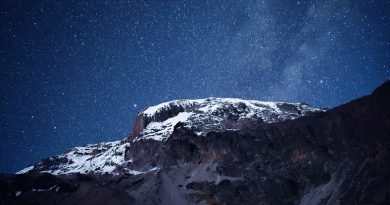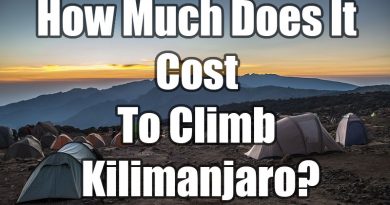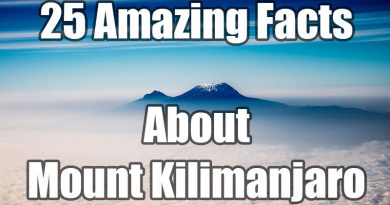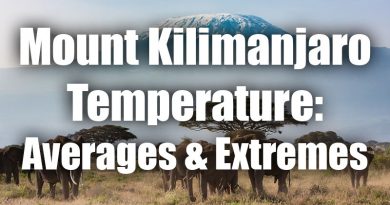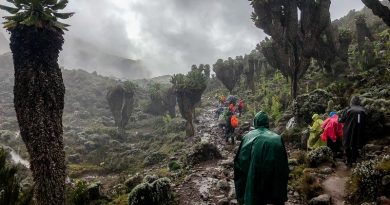Towering nearly 20,000 feet into the air, Mount Kilimanjaro is a colossal structure that’s impressive both for its sheer size and the vast array of ecosystems it hosts. As one might expect, then, weather on the mountain can vary greatly. For this reason, you’ll want to make sure that you understand the different weather and climate patterns on the mountain if you’re planning on taking a trip there any time soon.
In this guide, we’ll provide a complete breakdown of Mount Kilimanjaro weather, from the trade winds that generate much of the mountain’s climate conditions to average precipitation and temperature. With this information, you’ll be better able to plan your Mount Kilimanjaro vacation.
Keep reading to find out more about the various weather patterns you can expect from this legendary mountain!
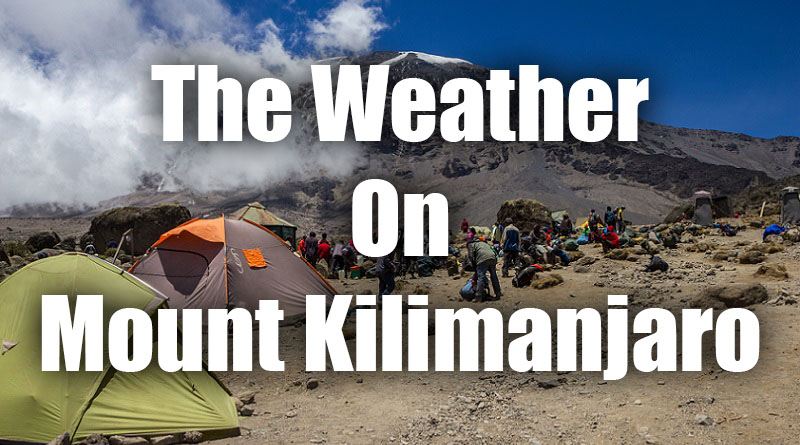
Mount Kilimanjaro Weather Overview
Let’s start by taking a general overview of Mount Kilimanjaro’s weather. Is the mountain hot or cold? Does it rain a lot? What’s the humidity like? Unfortunately (or fortunately, depending on your take), the mountain is all of these things and more. That’s because Kilimanjaro is divided geologically into five separate ecosystems, each one with its own unique climate. We’ll break down these ecosystems in greater detail later on, but for now simply know that these different ecological zones are the agriculture or cultivation zone, the rainforest zone, the moorland zone, the highland desert zone, and the glacial zone.
What this means for you is that you should expect a bit of everything when climbing the mountain. Independent of these different ecological zones, Mount Kilimanjaro also features wet seasons and dry seasons and a pretty steady year-round temperature. Coming up, we’ll look at each of these phenomena in turn, as well as give some advice on how to best the weather and reach the summit.
The Importance of Trade Winds
To truly understand the unique climate of Mount Kilimanjaro, you must first understand the trade winds and anti-trade winds that dictate weather conditions on the mountain. Primarily, there are two sets of winds—the South-East trade winds and the North-East anti-trade winds—that determine what the weather on the mountain will look like on any given day.
Before we jump into specifics, however, let’s step back and answer an important question: what exactly are trade winds? Essentially, these are winds that come from the ocean and carry moisture. When trade winds come into contact with solid surfaces of any substantial size or volume, they tend to condense and turn into clouds. This can then influence precipitation and other weather factors in that specific area.
With this in mind, let’s take a look at the two different sets of trade winds that influence weather on Mount Kilimanjaro:
South-East Trade Winds
Arising from the Indian Ocean, the South-East trade winds smash into Mount Kilimanjaro from March until May, bringing with them tons of moisture that turns into torrents of rain. As the name implies, the winds come from the south, meaning it’s largely the southern side of the mountain that gets wet. During this time, Mount Kilimanjaro is said to be in its “wet season” and hiking is generally more popular on northern trails such as the Rongai Route.
North-East Anti-Trade Winds
The next set of winds are unique in that they are not trade winds but rather “anti-trade winds,” which implies that the arrival of these winds effectively ends the effects of the former. These winds come from the north and force their way through the space between Kilimanjaro’s two peaks (Mawenzi and Kibo). This gap, affectionately known as the “Saddle,” serves as a meeting place for the two winds, where the North-East anti-trade winds force the South-East trade winds down toward the lower slopes of the mountain.
The effects of this are quite dramatic. Because the North-East anti-trade winds lose all moisture long before they reach Mount Kilimanjaro, they induce a period of dryness on the mountain that makes it easier hike. What’s more, by pushing the rains down, they limit rainfall to slopes 3,000 feet and lower. Lasting from late May to late October, these winds create better climbing conditions and coincide with the peak climbing season on the mountain.
Putting it simply, your Mount Kilimanjaro vacation ill be heavily influenced by the time of year you go—which will be influenced in large part by the trade winds that gain control of the mountain through large swaths of the year. Understanding these trade winds is the first step necessary for reaching the top of the mountain.
Altitude and Weather
To truly have a firm grasp on Mount Kilimanjaro weather, one must also understand the effect that altitude has on the climate. There are two main phenomena that happen with the change in altitude. Let’s take a broad look at both of them:
The Mountain Gets Colder
As anyone who’s ever made it to the top will tell you, Kilimanjaro features both temperature extremes. Specifically, you can expect temperatures constantly above 80 degrees F (and as high as 100 degrees F) at the base of the mountain. As you navigate to the top, however, this temperature will drop precipitously, with the temperature at the summit sometimes dropping as low as -20 degrees F.
Obviously, you’ll want to take this into account so that you have a better idea of what to expect with a trip on the mountain.
It Gets Harder to Breathe
As you climb toward the top, you’ll inevitably experience the effects of higher altitudes, which cause a reduction of oxygen in the air and decreased air pressure. In simple terms, the air gets noticeably thinner as you climb the mountain, with conditions at the top getting absolutely brutal for some climbers. These weather conditions can (and will, if you’re not careful) cause altitude sickness, which unfortunately claims some lives on the mountain every year. Remember: the only way to acclimate to these extreme altitudes is to climb slowly—so keep this in mind if you wish to best the mountain’s famously volatile weather.
Kilimanjaro and the Equator
Mount Kilimanjaro lies just 200 miles south of the equator. While this does mean that the mountain can get quite hot, it also has its advantages. Primarily, due to the mountain’s proximity to the equator, temperatures remain fairly constant on the mountain year round. In a nutshell, this means that you shouldn’t expect drastic temperature changes throughout the year. Rather, weather on the mountain is affected more by the trade winds and altitude, as mentioned above.
Breaking Down the Ecosystems
Just as important as the trade winds are the various ecosystems that make up the mountain. It may be helpful to think of the mountain as a pyramid of sorts, broken into five distinct levels based on altitude. Ranging from lowest to highest, the mountain goes from a thriving, humid, and tropical environment to an arctic desert that’s as brutal to maneuver as it is wonderful to conquer. In this section, we’ll break down the distinct ecosystems so that you have a better idea of what to expect when you climb the mountain.
Cultivation Zone
Ranging from 800 feet to 2,600 feet in the air, the cultivation zone is the only ecological zone of Mount Kilimanjaro with extensive human habitation. Small villages dot the landscape here, and agriculture is the main way of life. A wide variety of crops and livestock also thrive here on the mountain. Live thrives here due to heavy amounts of rainfall and the many rivers that are formed from glacial runoff from the top of the mountain. Indeed, the cultivation zone receives the largest amount of rainfall of any ecological zone on the mountain—meaning you are more likely to encounter wet conditions here than anywhere else during your trek up Kilimanjaro.
Rainforest Zone
Located just about the cultivation zone at 6,000 to 9,200 feet in the air, the rainforest zone also boasts its own unique weather. For starters, temperatures in the zone remain at a fairly constant 60-80 degrees F all year round, making it cool enough to hike without several layers. As the name implies, the rainforest zone also sees its fair share of rain and runoff from higher levels of the mountain. Here, humidity is often at 100%, meaning you’ll want to prepare clothes that will help you relieve excess sweat.
Moorland Zone
The moorland, or heath, zone ranges from 9,200 feet in the air to 13,000 feet, with weather that’s markedly different from the rainforest zone that precedes it. Here, the temperature is highly volatile; daytime sunshine can have you baking in 100-degree heat, but temperatures at night can drop to nearly freezing. In addition to the unpredictable temperature, climbers are also advised to prepare for the wind. While the moorland zone features low amounts of precipitation, it does boast some pretty intense winds that can rattle you if you’re not expecting them. As such, you’ll want to be sure that you dress accordingly.
This zone is also known for the fine mists that snake up and cover the landscape during the daytime. This can sometimes reduce visibility, so be sure that you are climbing with a porter you can trust.
Highland Desert Zone
If anything, the highland desert zone is even more erratic than the preceding moorland zone. Here, temperatures can soar to true desert-like conditions but drop well below freezing in the same day. Added to this, there’s a distinct lack of precipitation. Less than eight inches falls every year in this Kilimanjaro desert, deterring plant life and creating intense arid conditions. Keep in mind that the altitude here is also crazy, as the highland desert zone ranges from 13,000 to 16,000 feet in the air. At these altitudes, you’ll want to take it slow and easy so that you aren’t done in by the brutal climate.
Glacial Zone
Home to the mountain’s two peaks, the glacial zone is without a doubt the most brutal of the five ecosystems. Here, temperatures can drop as low as -20 degrees F, with a wind chill that’s just as cold. In simpler terms, the top of the mountain is freezing and can quickly take you out if you don’t come prepared. You can count on snow to fall in this zone throughout much of the year. Compounded with the intense altitude here, the cold conditions can make the glacial zone hard to maneuver even for experienced climbers. For this reason, it’s important that you choose a route that allows you to assimilate to both the altitude and the cold so that you can increase your chances of reaching the top.
Mount Kilimanjaro Wet Months
As we’ve touched on already, certain times on the mountain are wetter than others. Specifically, there are two wet seasons on the mountain, the first being the longer of the two. This first wet season lasts from March to mid-to-late May, with the second coming in November. Climbing during this period is generally not advised, particularly for first-time climbers. In addition to the large amounts of rain that fall during this time period, the mountain is also filled with constant fog and provides the extra danger of mud.
In addition to this, you’ll likely have to deal with large amounts of excess moisture permeating your clothes. Even if you wear good gear, you will be at risk for this. This extra moisture can make the mountain colder, something you definitely want to avoid when you get to higher altitudes. For this reason, you’ll likely come out better by choosing to climb during a different season.
With this being said, if you do choose to climb during either of the wet seasons, it’s better to choose a northern route. Generally speaking, these routes receive substantially less rainfall, making them better for climbers. The only routes through which you can reach the summit from the north are the Rongai Route, an easy, gradually sloping route where you can see both floral scenery and wildlife, and the new Northern Circuit Route, which takes travelers on a 360-degree panorama tour around the northern side of the mountain. No matter which route you choose, you’ll be able to avoid the brunt of the rainfall that comes with the wet season..
Mount Kilimanjaro Dry Months
Similarly, there are two dry seasons on Mount Kilimanjaro. The major dry season begins in July and and runs into October. For this reason, these are popular hiking months for climbers, despite the cooler temperatures that descend on the mountain during the middle of the year. Another dry spell occurs from January to February, but this season is shorter and less predictable, meaning there’s a higher likelihood of rain.
Understanding the wet and dry seasons will help you make a better decision on when to take your trip. With this in mind, be sure to reference this information when booking your flight!
Mount Kilimanjaro Visibility
In addition to these factors, you’ll also want to take visibility into consideration. The year starts out with high visibility in January and February, making these popular months for some climbers. Snow and rain make the March to May rainy season tough for any climber, in no small part due to the decreased visibility that comes with the rain.
Preparing for Mount Kilimanjaro Weather
With all this information in mind, what’s the best way to prepare for Mount Kilimanjaro’s weather? In this section, we’ll go over a few tips that will help you stay safe and comfortable while climbing.
1. Dress in Layers
Successful climbers all know this important tip: dress in layers. If you are serious about making it to the top of the mountain, you’ll want to maximize your chances of success by dressing to fit the situation at hand. This means having clothing prepared that will enable you to conquer the weather in each of Kilimanjaro’s five ecological zones.
In general, climbers dress in three layers: a base layer that’s compatible for the hotter and more humid conditions in the lower regions of the mountain, a mid-layer that will help you combat the volatile temperatures you’ll encounter the middle regions of Kilimanjaro, and a top layer that will protect you from all the nasty environmental hazards endemic to the glacial zone of the mountain.
For your base layer, consider clothing that is sweat resistant and suitable for 100% humidity. The cultivation and rainforest zones are known for being intensely humid, with high levels of rainfall to boot. For this reason, be sure to bring something that will protect you from the heavy rains.
The mid-layer should consist of clothing that will protect you from the cold. It’s important that you load up on well-insulated clothing here, as you’ll be facing some colder-than-anticipated temperatures. Consider down insulation for its ability to fight off tough colds.
You’ll want to do the same for your outer layer, which should also be weatherproof. At the top of the mountain, you’ll likely encounter snow, particularly at the beginning of the year. You’ll also face heavy winds that can pierce to the skin if you wear the wrong clothes. For this reason, make sure that you buy something that’s suited for extreme altitude and arctic conditions.
By preparing properly, you can make your Mount Kilimanjaro vacation smoother and safer. Knowing this, be sure to keep the above advice in mind.
2. Bring Some Heavy-Duty Equipment
In addition to your day-to-day clothes, you’ll also need to bring the right equipment. This includes waterproof hiking boots that will be able to withstand the moisture and general wetness of the mountain, both of which can be quite severe toward the base and in the rainforest zone. Additionally, you’ll want to bring along a sleeping bag that can keep you warm even in freezing conditions. While it may seem trivial, bringing the wrong gear can put you at risk for conditions such as frostbite and, at the very least, can make you so uncomfortable you’re unable to finish your trip.
3. Don’t Go Alone
We know—you’ll be going with a porter. Still, the fact remains that you don’t want to go to Kilimanjaro alone. Rather, it’s better to go with a climbing buddy or partner who can help you weather (see what we did there?) the conditions there. With two people, you also get the advantage of body heat, which can be extremely helpful in the high altitudes near the top of the mountain. Going with someone else also means that you can split carrying the luggage, which can greatly help out during your more-than-likely week-plus trip.
All of this will help ensure that you can best the weather and come out on top—literally. For this reason, consider going with a buddy or two if you’re truly looking to reach the summit.
Best Time to Go to Kilimanjaro
With all this in mind, when should you plan your Kilimanjaro trip? In light of the weather, most travelers tend to hike the mountain from December to March and June to October. These two periods correspond to the driest periods on the mountain, but vary by temperature. Specifically, the period between December and March is noticeably colder than the period from June to October. The advantage to this is that crowds are also significantly lower during this time, making it a good time to go if you don’t want to worry about the hustle and bustle of peak season.
We’ve written a whole article about the best time to climb Kilimanjaro, so if you’re thinking of planning your trips, it’s a good idea to check that out.
The Bottom Line
The first step to successfully climbing Mount Kilimanjaro is understanding the unique weather conditions that dictate life on the mountain. In this guide, we’ve gone over both the basics and the nitty-gritty of Kilimanjaro weather so that you can have a better understanding of what conditions are like across the mountain and why that is the case. We’ve also supplied a few weather-besting tips that will help you top the summit.
If you’re planning on climbing Kilimanjaro any time soon, make sure you use this guide to help you! By doing so, you can be sure you’ve got everything you need to make your journey a rewarding one!

